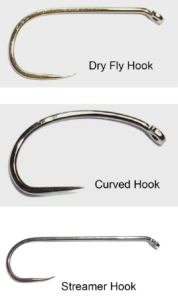Hooks for Fly Tying
Hooks can be broken into a few simple categories.
– Fine Wire for Dry Fly Hooks or Heavy Wire for Sinking Flies.
Hook Styles depend on the type of fly you are tying
– Dry Flies generally are tied on Straight hooks. I favor straight eyes, though most are available in down eye. Dry fly hooks use a light wire to better keep them afloat in the water surface film.
– Emerger and Nymph patterns are frequently better imitated on Curved hooks. They imitate the curved shape of an emerging nymph or crustacean. Most nymph hooks use heavy wire to better sink the fly under the surface film.
– Streamer hooks are generally longer than dry fly or nymph hooks. The longer hooks better emulate minnows or smaller fish that streamers are meant to emulate. Streamer hooks generally employ a heavy wire to sink.
Of course there are countless other types of hooks..this brief overview is simplification. Of recent use, the jig hook is gaining popularity when combined with a bead…the hook point rides up and seldom snags the bottom. Very good for streamers and nymphs.
No matter the hook you choose for your fly project, please pinch your barb prior to tying your fly. Pinching the barb will make it easier to release your fish unharmed and it may also protect your own safety. If you are buying hooks and barbless are available, by all means purchase them. Barbless are not as common, despite the risks to our rivers due to barbed hooks…go figure???

